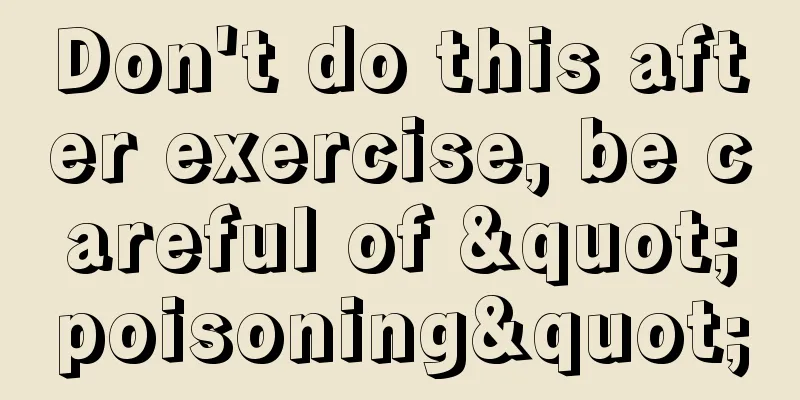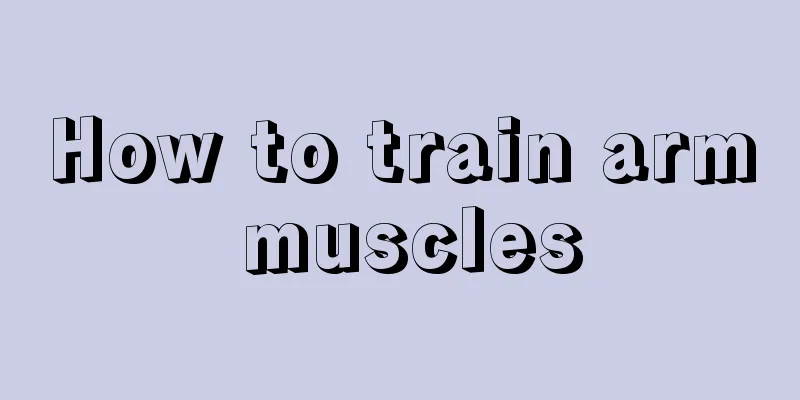Don't do this after exercise, be careful of "poisoning"

|
Exercise is a very good way to exercise the body. Exercise can excrete toxins from the body, relax your mood and reduce stress. However, exercise is not a simple thing. Have you noticed the many precautions after exercise? Do you have any of the 4 major misunderstandings after exercise? Do you know about nutritional supplements for exercise? Let's find out with the editor below. Many people like to drink a lot of water after exercise and sit on the ground to rest for a while. This is a wrong behavior and it is very harmful to our health. Myth 1: Drinking a lot of water after exercise Sweating during exercise will cause the body to lose water and electrolytes. Proper hydration is beneficial for maintaining fluid balance and helps promote body recovery. However, if you drink a lot of water, it may cause "water poisoning", with symptoms such as dizziness, vomiting, weakness, rapid heartbeat, and in severe cases, muscle spasms. In addition, if the water temperature is too low, it can cause gastrointestinal discomfort and abdominal pain. For people who exercise for a long time, it is recommended to drink small amounts of sports drinks before, during and after exercise, and keep the water temperature at 10℃~20℃. If you engage in exercise that requires a lot of physical exertion, you should replenish yourself with drinks containing oligosaccharides and peptides within 2 hours after the exercise. This will help the body's resynthesis of muscle glycogen and aid in fatigue recovery. Myth 2: Lie down or squat immediately after exercise After exercise, the body's functions remain active for a certain period of time, and it takes a certain amount of time for the functions of each system to recover. During strenuous exercise, a large number of capillaries in the lower limbs expand, and blood flow can reach more than 25 times that of resting state. The lower limb muscles continuously contract, promoting blood return through the action of "muscle pump". If you lie down or squat immediately after exercise, the muscle pump effect disappears and the amount of blood returning to the heart drops sharply, making you prone to dizziness, blurred vision, or even fainting. Therefore, it is recommended not to stop immediately after exercise. It is best to do some relaxation, tidying up or stretching exercises. You can also massage your muscles to promote fatigue recovery. Myth 3: Take a shower right after exercise After exercise, a lot of sweat is produced, the body temperature rises, and the skin takes away a lot of water. If you take a shower immediately after exercise, especially when the water is cold, the sweat glands will stop secreting sweat, and the heat will not be able to dissipate. This is not good for the body's recovery and may even cause muscle cramps, reduce immune function, and trigger diseases such as colds, flu, and bronchitis. It is recommended to wipe off sweat after strenuous exercise, avoid using electric fans or entering a very cold air-conditioned room, and wait until you stop sweating before taking a shower. Myth 4: Eating Blindly After Exercise During exercise, the motor central nervous system is in an excited state, the body's parasympathetic nervous system is relatively inhibited, the excitability of the digestive system is significantly reduced, gastrointestinal motility is weakened, and the secretion of various digestive glands is greatly reduced. The normal secretion of each digestive gland needs 20 to 30 minutes to recover after exercise, so it is recommended to take a short rest before eating after exercise. Generally speaking, active rest (i.e. relaxation, tidying up, and stretching) after exercise is more helpful in promoting fatigue recovery than passive rest (such as sitting or lying down to rest). It is best to choose different rest methods for different exercises, which can help the heart and muscles quickly eliminate fatigue. For example, when riding a bicycle, the back remains arched for a long time, which can easily cause fatigue and soreness in the back and arms. After exercise, you can massage tired parts of your waist and legs, or practice some yoga moves to stretch your waist to relax your muscles. After running, you should do some leg stretching exercises to reduce muscle soreness and joint injuries. You can also take a tennis ball and roll it from the ankle to the back of the knee, and massage the painful area several times. |
<<: Playing basketball like this will make that thing grow longer and longer
>>: How many of the top ten recognized fat-burning exercises have you tried?
Recommend
How to drink boiled water to lose weight?
Many people are constantly working hard through v...
Seven ways to jump rope can help you lose weight quickly
1. Simple rope skipping method Warm-up: Put your ...
How to run without muscles?
Maybe many of us have improved our physical fitne...
Can fitness help you lose weight?
Nowadays, there are many obese people, so can fit...
How many swimming strokes are there?
Everyone knows that swimming is very good for peo...
Benefits of Aerobics for the Elderly
In fact, the elderly should do aerobics more. Onl...
How many sit-ups do you do a day to lose weight?
In real life, many people find that they often do...
The fitness effect of running in place
Due to time or work reasons, many friends are una...
What is the best time to run?
Although running is good for people's health,...
What are the precautions for wild swimming?
In the hot summer, many people like to spend time...
What are the precautions for outdoor mountaineering?
Many friends go hiking when they have time. This ...
How to practice golf?
Golf is an outdoor sport that combines physical e...
There are also mistakes in weight loss exercises. 5 blind spots make you gain weight
The main reason why exercise is not effective in ...
What are the effects of hot yoga?
Yoga is a very popular health-preserving exercise...
The reason why running is not effective in losing weight
I believe everyone knows what running is. Running...









